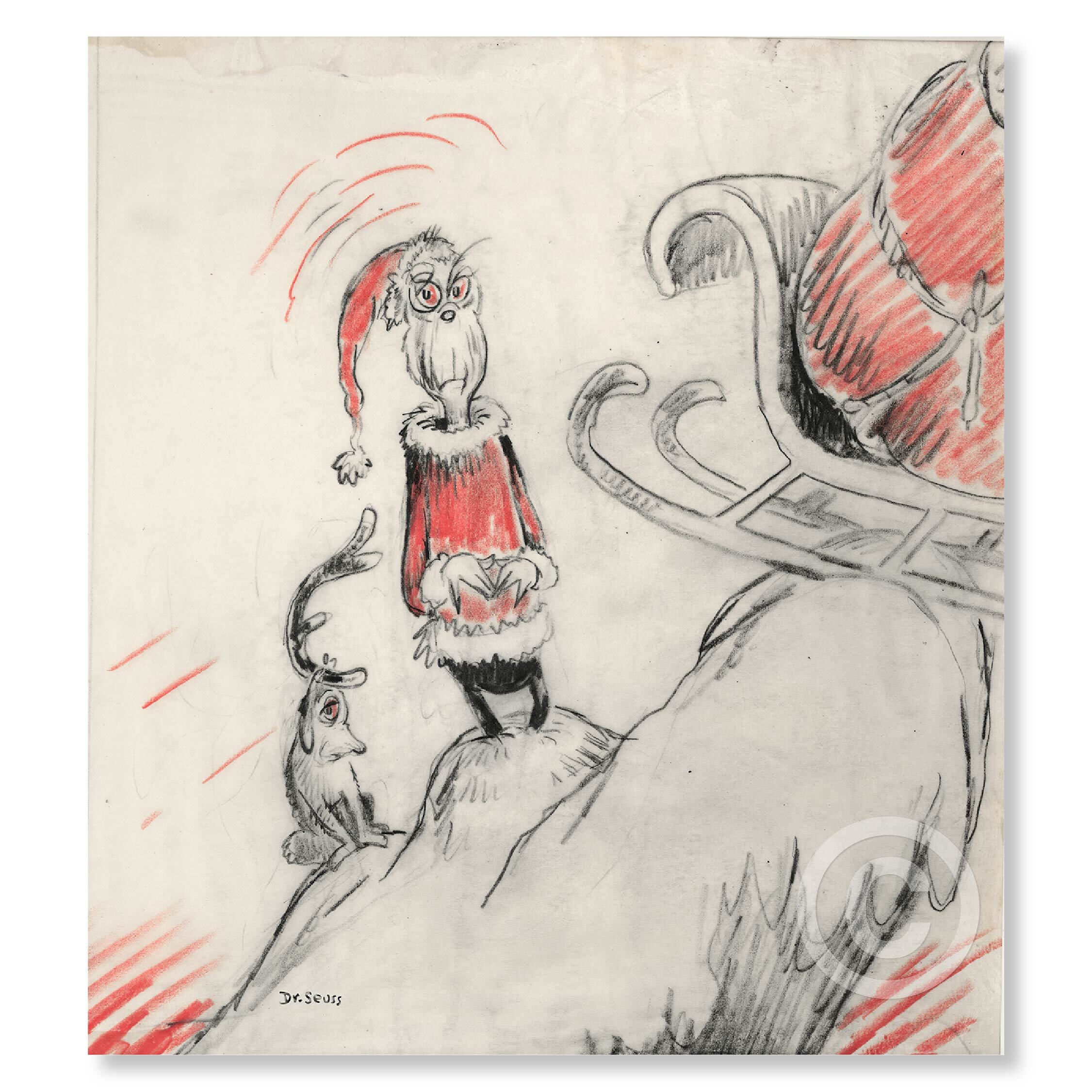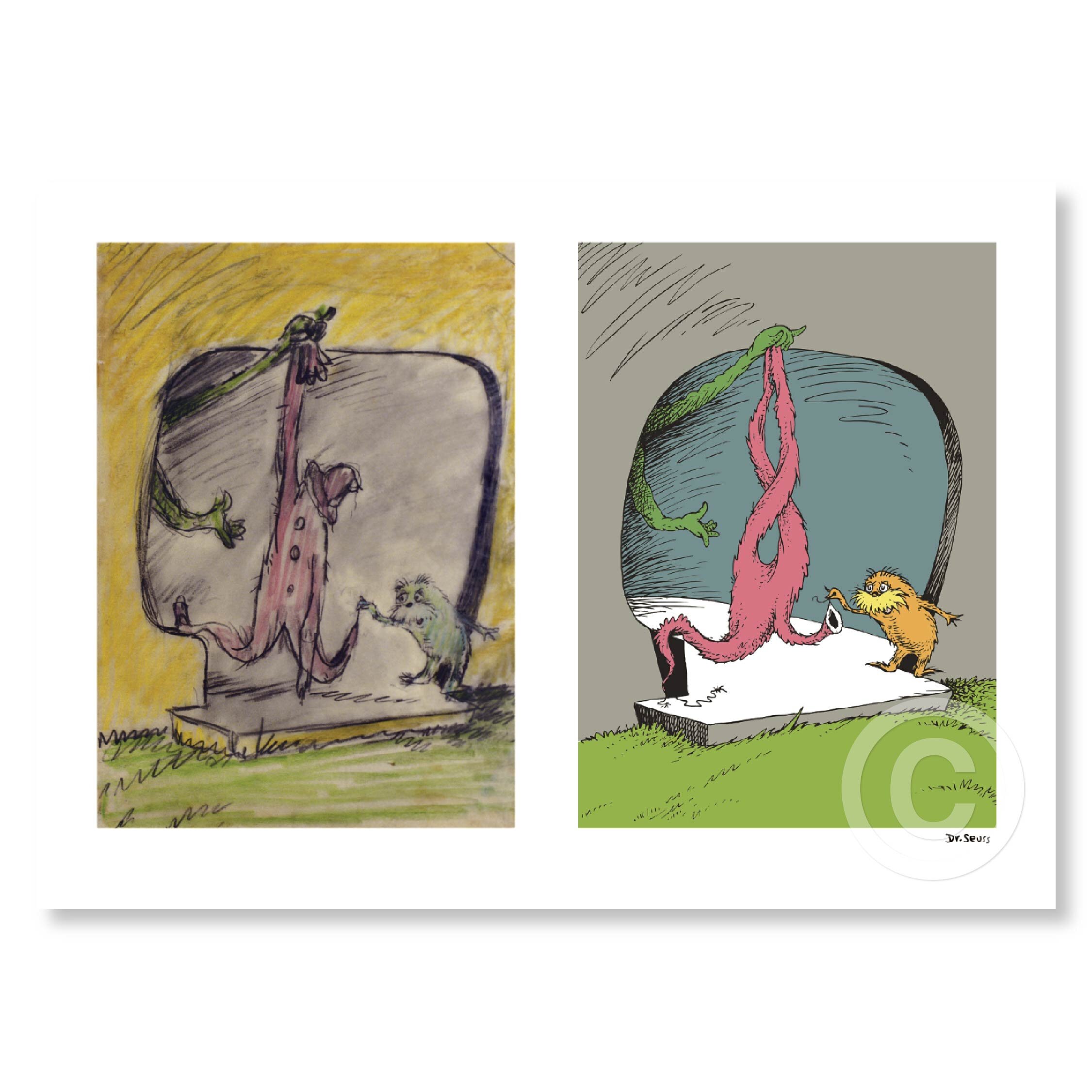OUT of the box
came thing two
and thing one
A CHILD AT HEART
It is widely reported that The Cat was Ted Geisel’s (aka Dr. Seuss) alter ego. Like Ted, The Cat stands tall with the stature of an adult, but is clearly a child at heart. To celebrate Seuss’s insightful perspective, we are proud to announce the first Triptych in the Art of Dr. Seuss Collection. This historic work features a series of three rough drawings from 1957 and highlights the first drawings ever made of Thing One and Thing Two.
Out of the Box Came Thing Two and Thing One - Triptych
Pigment Print on Archival Paper
Image Size: 11"h x 14”w (left and right), 11”h x 14.75”w (center)
Paper Size: 14.5”h x 48.75”w
Limited Edition of 850 Arabic Numbers, 99 Patrons’ Collection, 155 Collaborators’ Proofs, 5 Hors d’Commerce, and 2 Printer's Proofs
“Dr. Seuss’s thoughtful intent was for children to recognize his words and drawings as familiar, while at the same time coaxing out that feeling of unimpeded childhood fun.”
THE PLAYFUL WILD SIDE IN EVERY CHILD
Thing 1 and Thing 2
It’s as if Dr. Seuss felt it would take reinforcements to break through the restrained adult sensibilities exhibited by Sally and her brother. His solution was a game he called “fun-in-a-box,” and with it came the introduction of Thing One and Thing Two. These now legendary sidekicks embody the playful and inherent wild side rooted in nearly every child, and hopefully within ourselves as well.
OUR IRRESISTIBLE CURIOSITY
Ted’s opening image plays upon our most basic curiosity. The anticipation and visual reference to Pandora’s box is impossible to resist. His first impulse here is to intrigue us, not in the drawing’s details (or lack thereof), but in the gesture of The Cat and the posture of the children.
If we follow this early concept image through to its final drawing in the book (seen below), we see Ted push our curiosity even further. He repositions the children nearly upon the box! Our own inner child cannot help but lean into the box with them, our noses almost touching and hearts pounding, sparking our sense of youthful wonderment.
FIRST IMPRESSIONS
In the center image of the triptych, we meet Thing One and Thing Two for the very first time—directly from Ted’s mind onto the drawn page. As adults we have been told, “You only have one chance to make a first impression.” Ted takes that advice to heart, focusing his first pencil strokes intently on Thing One and Thing Two: confident, sure-footed, and full of energy. It’s all about personality and, in bestowing such big personalities upon these two small characters, Ted ignites our own independent will.
CONFIDENT,
SURE-FOOTED
& FULL OF ENERGY
In an unexpected twist, Ted stops the action here for a surprising moment of good manners. We all know that when we let ourselves go—to be playful like a child—we should not abandon our basic human decency. In these three images, Ted seizes this opportunity to foreshadow serious childhood fun and shows us that to be playful isn’t innately “bad.” He encourages us to let our inner child out of the box while remembering to be decent and kind.
“Ted encourages us to let our inner child out of the box while remembering to be decent and kind.”
Image Three
AN HISTORIC RELEASE
This series of three critical concept drawings not only mark the debut of Thing One and Thing Two, they offer us insight into the nuances of Ted’s creative process. He was tireless in his pursuit of artistic excellence. Each gesture, expression, and composition had to propel the fantasy forward and, collectively, each page had to peel back another layer of childhood fun.
This historic release marks the first time three images appear in a single print and, as such, is one of the rarest works in the entire Art of Dr. Seuss Collection.













